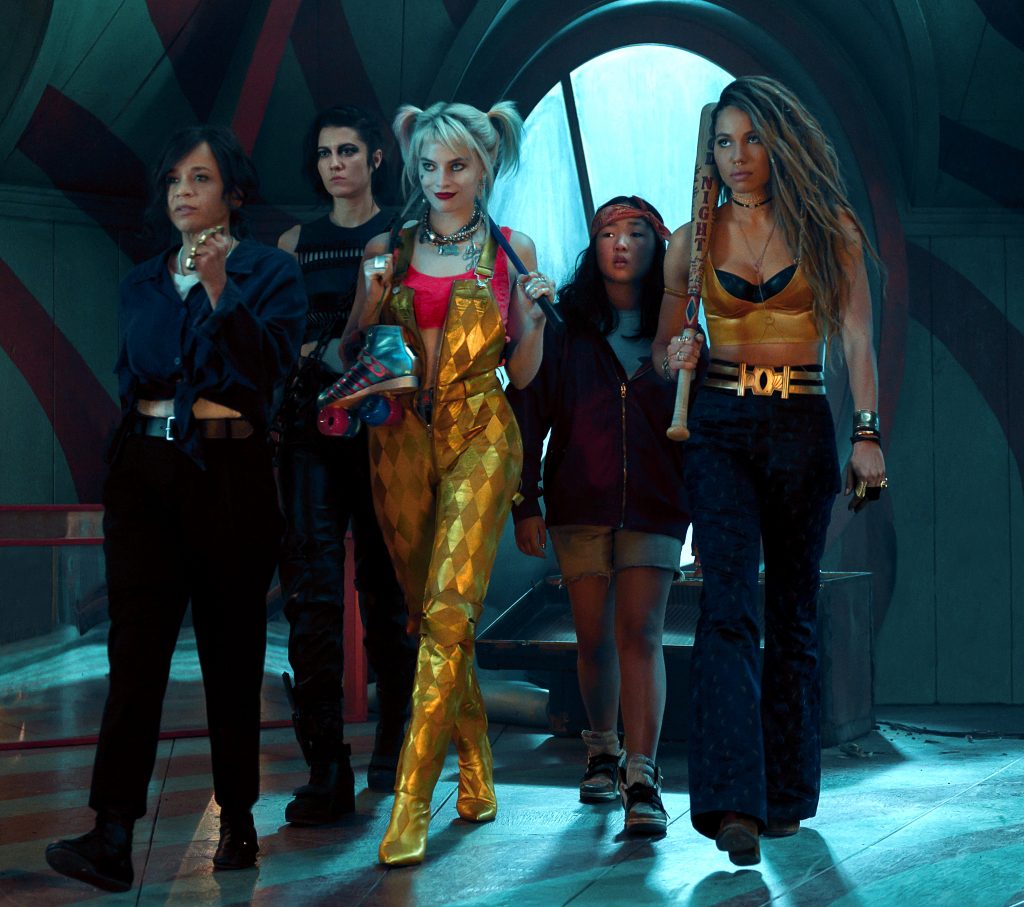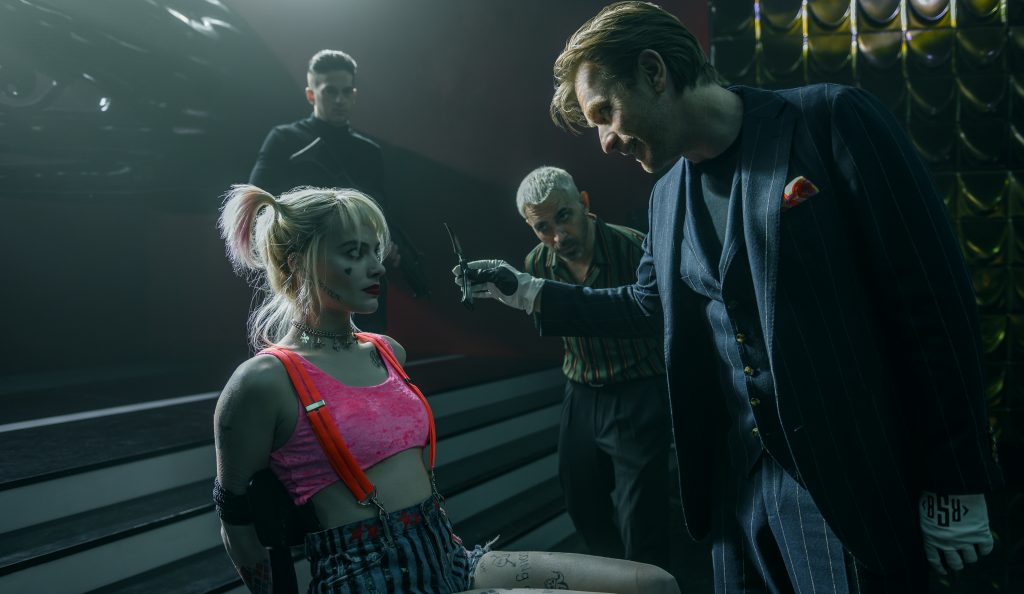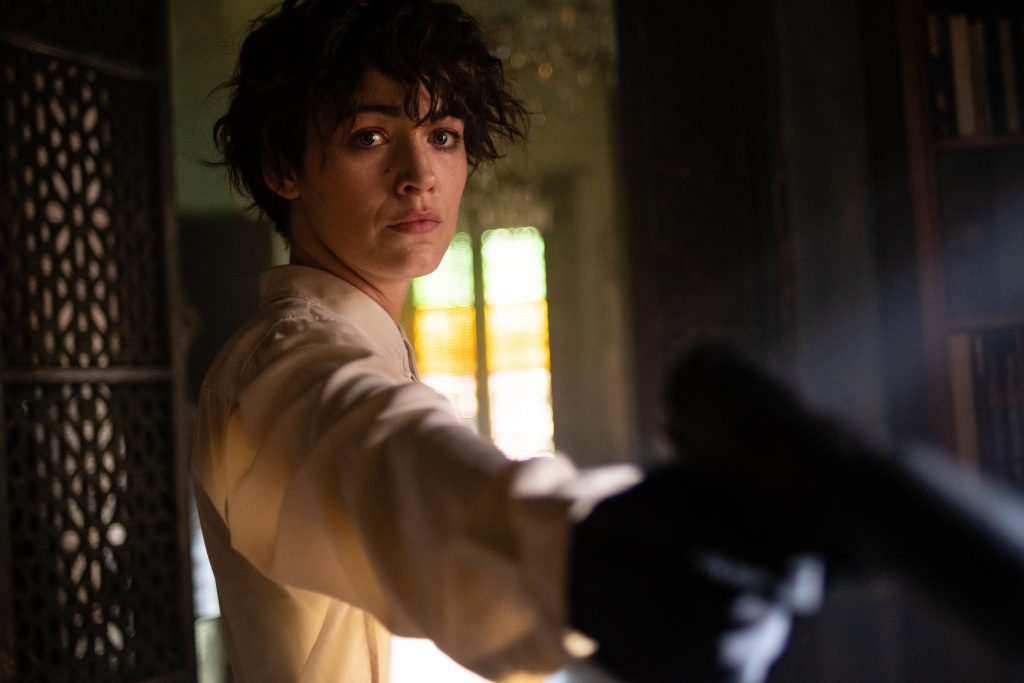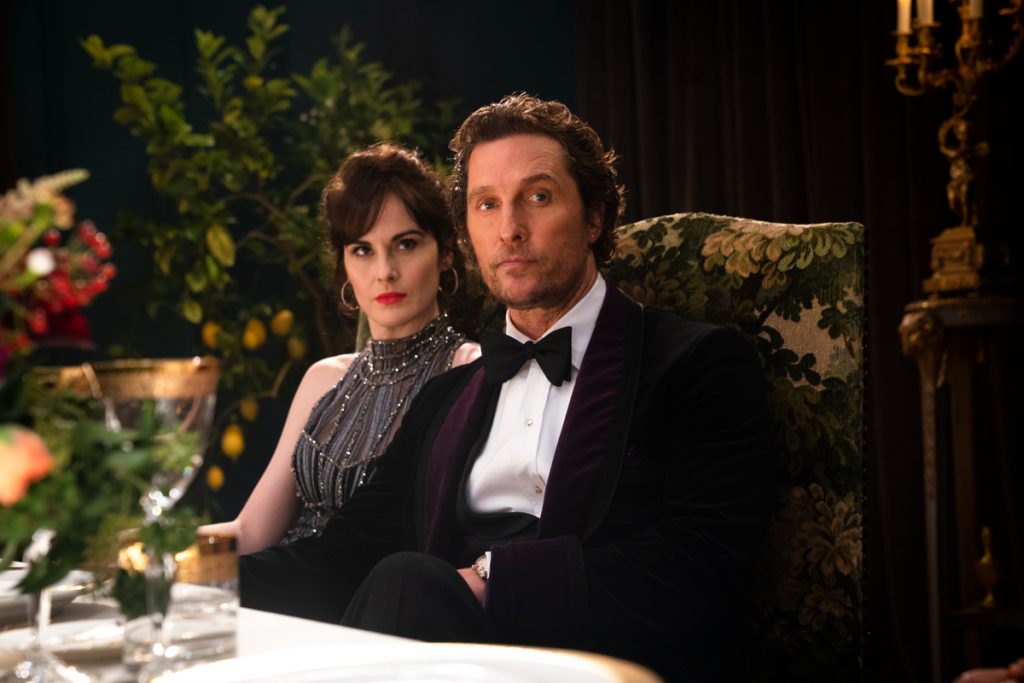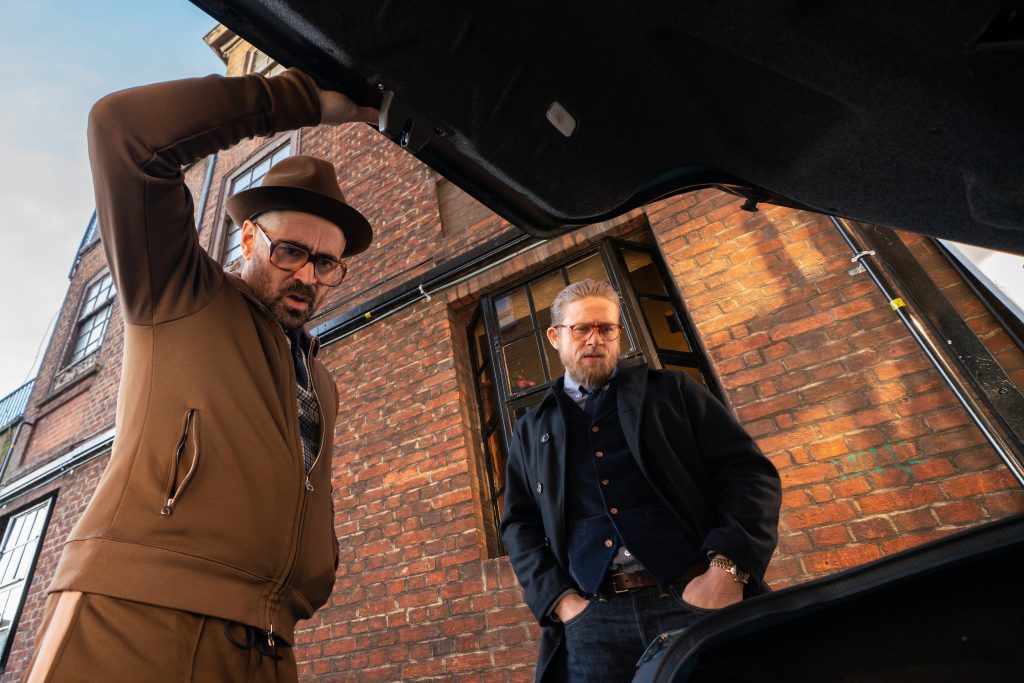February 21, 2020
by Carla Hay
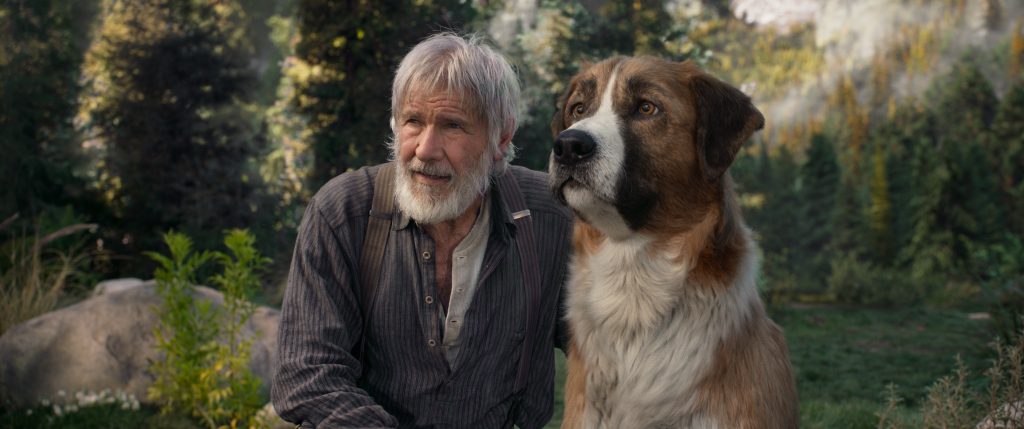
Directed by Chris Sanders
Culture Representation: Taking place primarily in Alaska during the 1890s Gold Rush era, the action-adventure film “The Call of the Wild” has a predominantly white cast that represent the working-class and middle-class whose lives are touched in some way by a very lovable and determined St. Bernard/Farm Collie mix dog.
Culture Clash: The characters have conflicts over greed for gold, as well as ownership of the dog.
Culture Audience: “The Call of the Wild” is a family-friendly film that will appeal to fans of Harrison Ford and people who love dogs.
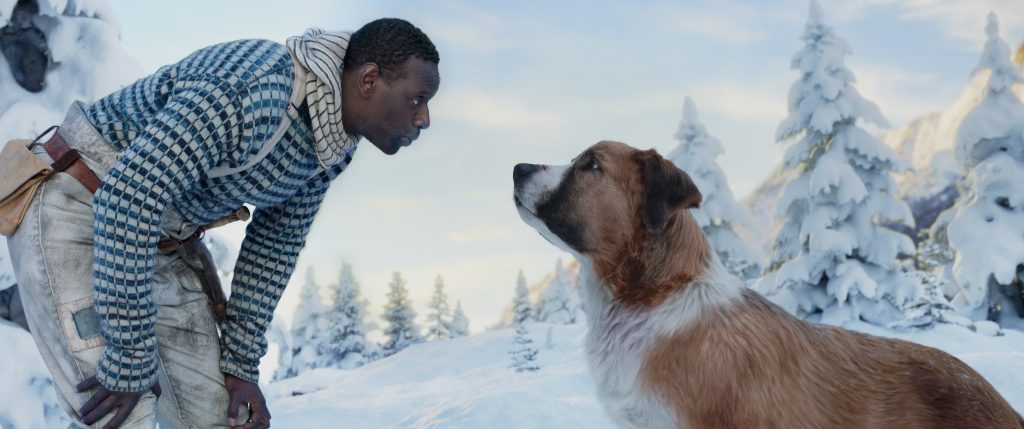
“The Call of the Wild” takes Jack London ‘s classic 1903 novel on which it based and turns it into live-action/animated hybrid adventure story with moments that are heartwarming, heartbreaking and unapologetically sentimental. The story, which takes place during the 1890s, centers on a St. Bernard/Farm Collie mix dog named Buck, who teaches the humans quite a few things about bravery and emotional intelligence. Harrison Ford receives top billing in the movie, but viewers who don’t know the book’s original story should know that his John Thornton character is mainly in the latter half of the story, although his voiceover narration is throughout the film. The movie keeps most of the plot points the same as the original story, but there are also some changes from the novel.
When viewers first see Buck, he’s living a pampered life in Santa Clara, California, with Judge Miller (played by Bradley Whitford), his wife Katie (played by Jean Louisa Kelly) and their family. Buck is playful and mischievous—so much so, that he ruins the family’s Thanksgiving dinner by trashing the table and eating the entire Thanksgiving feast. Judge Miller gets angry but he’s a kind dog owner who doesn’t abuse his pet.
One night, Buck is stolen by a man who sells the dog to an abusive sailor, who hits Buck with a club and keeps him confined. There are scenes of animal cruelty that might be a little disturbing to very sensitive viewers. Buck is on a ship that is headed to Alaska. Through ingenuity, luck and a will to fight, Buck escapes his cruel owner and finds himself homeless in Dawson City, Alaska. He is taken by an old man, who doesn’t treat Buck much better than the sailor, so Buck runs away again.
While Buck is escaping, he runs into a gold prospector named John Thornton (played by Ford), a recluse who’s come into town for errands. Buck finds John’s harmonica on the street, and John is struck by how intelligent the dog seems to be. Unfortunately, Buck’s old man owner catches up to Buck and he’s back in captivity again.
Buck is eventually taken to a dog pound, where he’s bought by Perrault (played by Omar Sy), a French Canadian who runs a dog-sled service that delivers mail. Perrault immediately warms up to Buck, but his jaded assistant Francoise (played by Cara Gee) isn’t too fond of the dog at first. (In the novel, the dog-sled operators were two men named Perrault and Francois.) Perrault makes Buck part of the dog-sled team, which is lead by an arrogant alpha male Siberian husky named Spitz. The rest of the dogs are of various large-sized breeds.
The dog-sled work is grueling, especially when it’s in the snow, but Buck is a quick learner and he makes friends with the rest of the dogs, except for Spitz. For example, there’s a scene where Spitz makes the other dogs wait for him to finish drinking water from an icy lake, but Buck takes his paws to break open the ice to create a new place where the dogs can drink without waiting for Spitz.
It’s worth mentioning that the CGI visual effects for the animals start off looking very unrealistic, but they get better during the course of the movie. The animals have very humanistic facial expressions and movements, so don’t expect this movie to be completely realistic. You also have to suspend disbelief at some of the superhuman stunts that Buck is able to do. However, the movie doesn’t go too far with the human characteristics for the animals—the animals don’t cry, walk like humans, or talk in human languages—so overall the ways that the animals are presented are mostly realistic.
Whenever there’s an action movie that takes place near a frozen body of water, the inevitable happens: Someone falls through the ice into the water. This happens to Francoise, but of course Buck is there to rescue her and save her life. Her attitude toward Buck starts to change after that incident. She begrudgingly admits to Buck that she underestimated him and that he’s impressed her the most out of all of the dogs in the pack. And wouldn’t you know, Spitz is off in the distance seeing this bonding moment and gets jealous, so he later starts a fight with Buck, leading to a showdown over who’s going to be the alpha male of the pack.
Because the trailers for “The Call of the Wild” make the movie look like it’s only about Buck and John, viewers who don’t know the book might be surprised to see how much of the movie is about Buck’s time in the dog-sled pack. It’s a pivotal part of the story in the novel and the film, because it’s the first time that Buck experiences being part of a dog pack. It’s also the first time he becomes in touch with his wild instincts that originate from the wolves who are ancestors of domesticated dogs. (When Buck uses his primal instincts, he sees a vision of a black wolf with glowing eyes )
So how did Buck end up with John? Buck and the sled team get a new owner named Hal, a greedy, insufferable fop who’s the most abusive owner yet for Buck. Hal wants the dog pack to take him, his sister Mercedes (played by Karen Gillan) and Mercedes’ passive husband Charles (played by Colin Goodell) on gold mining expeditions. Hal beats and starves the dogs into submission. If you love animals, this part of the film is hard to watch, even if you know the animals aren’t real.
Luckily, when John encounters the gold-digging trio and the mistreated dog pack, he rescues a severely malnourished and injured Buck. Hal leaves with the rest of the pack. (What happens to Hal and the dog pack in this movie is different from what happens to them in the original novel.) John takes Buck back to his small and sparse cabin in the woods and nurses the dog back to health.
John lives simply, and his gruff exterior masks a lot of emotional pain. He’s the type of prospector who isn’t looking for gold to get rich. At one point, he tells Buck that all a man needs is enough money “to buy groceries for life.” And it’s easy to see why he feels a strong connection to Buck, because Buck has also experienced a lot of pain.
During Buck’s time with John, Buck meets a pretty female hinterland wolf with white fur, and she introduces him to her pack, which readily accepts Buck, and he spends more and more time with them. (This is where the movie takes a sharp turn from reality, because in real life, a domesticated dog would be attacked and probably killed by a pack of wild wolves.)
It’s during this time that John (who talks to Buck like a human) reveals what happened in his past that’s made him a such a recluse: He had a son who died (it’s not mentioned how he died), and the grief over his son’s death led to him being estranged from his wife. It’s implied in the movie that John left his wife, they’re now divorced, and he let her keep their marital house and everything in it.
John is also a heavy drinker—and this is where the humanistic qualities of Buck are really shown in the movie—the dog scolds John for drinking too much, whether it’s by Buck hiding John’s flask of alcohol or making disapproving noises when he sees John drinking too much. Yes, Buck is not only an incredibly resourceful dog, apparently he’s also an addiction counselor/interventionist too.
Whenever there’s a movie about the wild, wild West, there also seems to be an obligatory scene with a bar fight. That moment comes when John is drinking at a bar and he gets sucker-punched by Hal, who’s angry at John because the dog pack ran off, thereby putting a severe damper on Hal’s gold-digging excursions in the rough terrain. Of course, Buck comes to the rescue when John is attacked. John fights back too, and Hal is thrown out of the bar. Do you think that’s the last we’ll see of Hal in this movie? Of course not.
The rest of the movie is about the bonding time that Buck and John spend together when John decides to take the adventure trip that he and his son had planned before his son died. “The Call of the Wild” is the first movie with live action for director Chris Sanders, who previously directed the animated films “How to Train Your Dragon,” “The Croods” and “Lilo & Stitch.” Fans of the “How to Train Your Dragon” series might see some similarities in the “man’s best friend” theme in both movies and how the animals take on human mannerisms.
There have been other “The Call of the Wild” movies, but this is the first to have this type of CGI animation for the animals. For the most part, it works well, even if the action sometimes look cartoonish because of what some of the things these animated animals do that real animals can’t do. However, this version of “The Call of the Wild” (whose screenplay was written by Michael Green) keeps the story’s message of resilience and friendship intact and treats it with respect. It’s a timeless message that will resonate even with changes in movie technology.
20th Century Studios released “The Call of the Wild” in U.S. cinemas on February 21, 2020.
UPDATE: Because of the widespread coronavirus-related closures of movie theaters worldwide, 20th Century Home Entertainment has moved up the digital release of “The Call of the Wild” to March 27, 2020.

